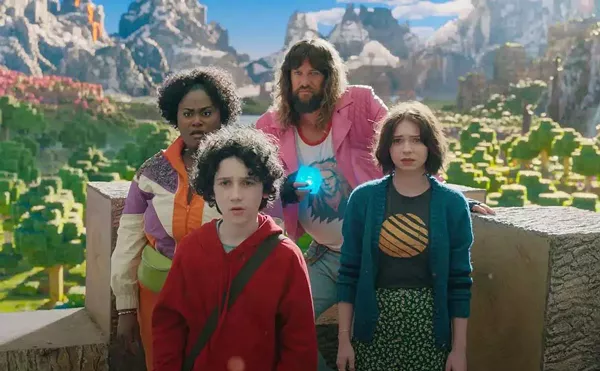Those who actually saw Richard Linklater's 2001 psychedelic head-trip The Waking Life had one of two reactions: 1) liked it but wished they'd seen it high, or 2) hated it because it induced epileptic seizures. Using an animation technique known as interpolated rotoscoping — a process that involves filming live actors then, frame by frame, overlaying animation — the movie featured a flickering, ever-changing landscape that broadcast the thoughts and emotions of its overly chatty characters.
In tackling the drug-induced paranoia of Philip K. Dick's sprawling novel A Scanner Darkly, Linklater has found a much better match for his jittery animation technique. His lush chameleon-like visuals enhance Dick's schizophrenic view of modern society and give the film an unsettling sense of disorientation and dread.
Keanu Reeves plays Bob Arctor, an undercover narcotics cop assigned to infiltrate a group of low-rent drug dealers. Wearing a "scramble suit" that disguises his identity by creating an ever-shifting cycle of physical appearances, Bob has begun to lose track of who he really is. He gets hooked on a new drug called "Substance D," takes up residence with a pair of drug-ravaged users — Jim Barris (Robert Downey Jr.) and Ernie Luckman (Woody Harrelson) — and falls in love with a mysterious young addict named Donna (Winona Ryder). Still, through the fog of confusion and displacement, Bob flashes on memories of a wife and kids and a home in the suburbs.
Since Arctor's identity is effectively unknown, he's ordered to initiate surveillance on the department's No. 1 drug-dealing suspect — himself. The line between reality and imagination blurs and no one is quite who they seem.
Despite its science fiction trappings, Scanner is more a cautionary tale about the dislocation and despair that accompanies drug addiction. Linklater remains faithful to Dick's themes while tying in aspects of our modern culture to demonstrate how drugs, surveillance and technology are used to suppress freedom of thought and action. He does a terrific job of reminding us how prescient Dick's cynical and suspicious vision of America was in 1977: His vision of a dystopian and commonplace world cowed by economic interests and personal mistrust is eerily familiar and gets under your skin.
Linklater has cleverly cast his film, exploiting his actors' talents and personal histories. Reeves is excellent as the perpetually disoriented Arctor, proving once again that this continually undervalued actor is willing to make interesting career choices. Downey Jr. is in full-tilt motor-mouth mode, letting his psychotic freak-flag fly high. Harrelson fuses his deadhead persona with the loopy simplicity of his Cheers character, Woody Boyd, to good comic effect, and Rory Cochrane is terrific as the brain-fried Charles Freck, an addict tormented by imaginary insects. But the most surprising performance comes from Winona Ryder, turning in her best performance in years.
Though there's no disputing the impressive dreamlike effects of the animation, it sometimes distracts from important dialogue. More than a few viewers may find themselves quickly lost, unable to follow Dick's scattershot narrative. And Linklater's rambling pace and haphazard structure occasionally grinds the story to a halt, robbing the film of the full impact of Dick's nightmarish sense of humor. While Linklater captures the characters' nonchalant self-destruction, he undersells the comedy of their inane, addict logic. Only the scenes with Robert Downey Jr. find the right delusional tone.
A Scanner Darkly is not for everyone. It's a complicated film that requires patience and, most likely, subsequent viewings to appreciate the jigsaw view of control and paranoia. While it's lush visuals give it an unexpected style and atmosphere, it's the actors — particularly Reeves and Downey Jr. — who expertly capture how people turned inside out by drugs struggle to maintain a veneer of normalcy in a life that is slowly disintegrating.
Showing at the Main Art Theatre (118 N. Main St., Royal Oak; 248-263-2111).
Jeff Meyers writes about film for Metro Times. Send comments to letters@metrotimes.com.






